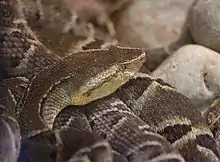Bothrops moojeni
Bothrops moojeni, commonly known in English as the Brazilian lancehead, is a species of venomous snake in the family Viperidae.[2] It is a pit viper endemic to South America.[1]
| Bothrops moojeni | |
|---|---|
 | |
| Scientific classification | |
| Kingdom: | Animalia |
| Phylum: | Chordata |
| Class: | Reptilia |
| Order: | Squamata |
| Suborder: | Serpentes |
| Family: | Viperidae |
| Genus: | Bothrops |
| Species: | B. moojeni |
| Binomial name | |
| Bothrops moojeni | |
Etymology
The specific name, moojeni, is in honor of Brazilian zoologist João Moojen de Oliveira (1904-1985).[3]
Description and Behavior
Grows on average 160 cm, with a maximum of 230 cm already reported, has a tan, gray-brown or olive-gray color, with fourteen to twenty-one trapezoidal side marks that are dark gray or completely black, 23 to 29 lines of dorsal scale of the average body, with the belly usually white or cream with dark gray spots scattered, while juveniles have a white tail. It is terrestrial, of nocturnal habits.[4] it is considered very aggressive, able to make vertical boats, sometimes reaching the highest parts of the body.[5] its body is viscous, varying from medium to heavy, broad head, flattened in a lance when seen from above and distinct from the narrow neck, the snout is not elevated, the eyes are medium in size, with lipid pupils vertically, while the scales back are keeled.[6] B. moojeni is viviparous.[7] Gestation lasts around four months, occurs once a year and 12 to 14 puppies are usually born. Live an average of 15 years.[8] It feeds on small mammals, birds, lizards, snakes and amphibians.[8]
Geographic range and Habitat
B. moojeni is found in Argentina, Bolivia, Brazil, and Paraguay.[7]
The type locality is Brasília, Distrito Federal, Brazil.[7] B. moojeni inhabits Araucaria moist forests and the Cerrado.[9]
Common names
In South America common names for B. moojeni include caiçaca, caissaca, caiçara, jacuruçu, and jararação.
Venom
Its venom has hemolytic and proteolytic action.[10] B. moojeni venom contains a wide variety of enzymes, such as acidic phospholipase, base A phospholipase, metalloproteinases, serine proteinases, L-amino acid oxidase, and a myotoxin phospholipase A2. The myotoxin phospholipase A2 causes necrosis in muscle fibers, releasing creatinine kinase.[11] Symptoms may include intense local pain, edema, muscular necrosis.The venom has an anticoagulant effect on the blood, makes the blood uncoagulable, causes severe hemorraghes and strokes.[12][13] The venom has a lethal dose of 0.205 mg / kg for horses.[14] The average yield for an adult female is 335 mg, 63 mg for newborns, specimens from Minas Gerais, Brazil have been reported to be 118 mg, specimens from Argentina have a yield of 248.0 ± 37 mg.[6]
References
- "Bothrops ". Integrated Taxonomic Information System. Retrieved 1 November 2012.
- McDiarmid RW, Campbell JA, Touré TA (1999). Snake Species of the World: A Taxonomic and Geographic Reference, Volume 1. Washington, District of Columbia: Herpetologists' League. 511 pp. ISBN 1-893777-00-6 (series). ISBN 1-893777-01-4 (volume).
- Beolens, Bo; Watkins, Michael; Grayson, Michael (2011). The Eponym Dictionary of Reptiles. Baltimore: Johns Hopkins University Press. xiii + 296 pp. ISBN 978-1-4214-0135-5. (Bothrops moojeni, p. 182).
- https://www.acq.osd.mil/eie/afpmb/docs/lhd/venomous_animals_byspecies.pdf
- "Jararaca-caiçaca – ZOO" (in Portuguese). Retrieved 2020-10-11.
- "WCH Clinical Toxinology Resources". www.toxinology.com. Retrieved 2020-11-26.
- Species Bothrops moojeni at The Reptile Database . www.reptile-database.org
- "Bothrops moojeni - Disciplina - Biologia". www.biologia.seed.pr.gov.br. Retrieved 2020-09-15.
- Borges RC, Araujo AFB (1998). "Seleção de habitat em duas espécies de jararaca ( Bothrops moojeni Hoge e B. neuwiedi Wagler) (Serpentes: Viperidae)". Revista Brasileira de Biologia 58 (4): 591-601. (in Portuguese).
- "Caiçaca". zoologia.comunidades.net. Retrieved 2020-09-15.
- Queiroz, M. R.; Mamede, C. C.; Fonseca, K. C.; Canabrava, Lcmn; França, L. V.; Silva, M. C.; Stanziola, L.; Beletti, M. E.; Canabrava, H. a. N.; Oliveira, F. (00/2011). "Biological characterization of a myotoxin phosphoplipase A2 homologue purified from the venom of the snake Bothrops moojeni". Journal of Venomous Animals and Toxins including Tropical Diseases. 17 (1): 49–58. doi:10.1590/S1678-91992011000100007. ISSN 1678-9199. Check date values in:
|date=(help) - "Jararaca-caiçaca – ZOO" (in Portuguese). Retrieved 2020-09-15.
- "Folha de S.Paulo - Proteína de serpente pode deter trombose - 25/07/2005". www1.folha.uol.com.br. Retrieved 2020-09-15.
- Sousa, Melina Garcia de; Tokarnia, Carlos Hubinger; Brito, Marilene de Farias; Reis, Alessandra Belo; Oliveira, Carlos Magno; Freitas, Nayra Fernanda; Oliveira, Cairo Henrique; Barbosa, José Diomedes (September 2011). "Clinical and pathological aspects of the experimental poisoning by Bothrops snakes in horses". Pesquisa Veterinária Brasileira. 31 (9): 773–780. doi:10.1590/S0100-736X2011000900009. ISSN 0100-736X.
Further reading
- Hoge AR (1966). "Preliminary account on Neotropical Crotalinae (Serpentes: Viperidae)". Memórias do Instituto Butantan 32 [1965]: 109–184. (Bothrops moojeni, new species).